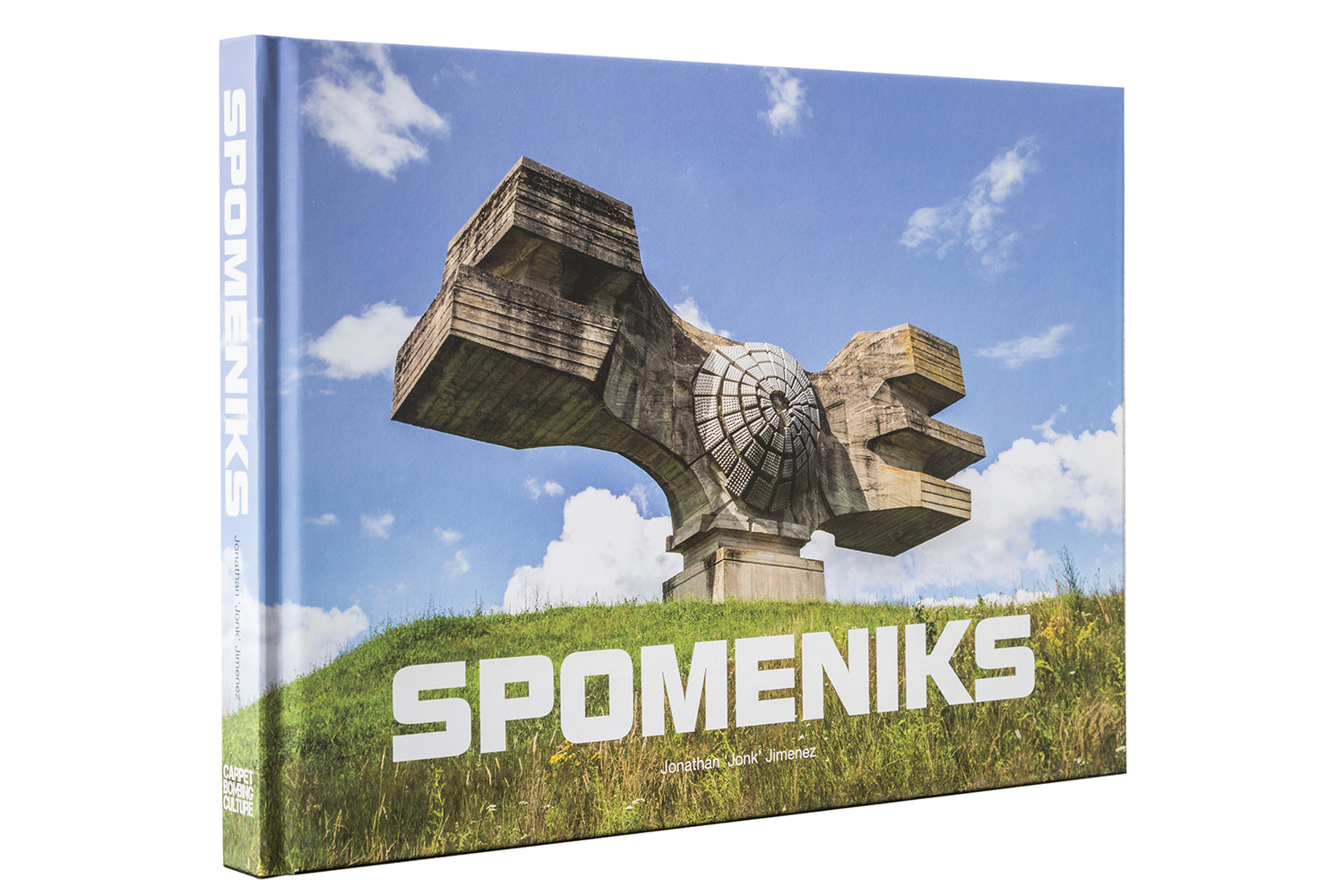
- Hardcover – 200 pages
- Publisher: Carpet Bombing Culture
- Language: English
- Size: 29.7cm x 21cm
- ISBN-13: 978-1908211682
Released in August 2018 under Jonathan “Jonk” Jimenez
A word from the editor:
Spomeniks literally means ‘Monuments’ in Serbo-Croatian. Some see spaceships conspicuously parked up in the middle of nowhere, others see a concrete legacy of both Yugoslavia’s emergence from World War II and its hopes for the future.
Follow in the footsteps of French photographer Jonathan ‘Jonk’ Jimenez as he tries to track down these super-sized structures. Once counted in their thousands and attracting huge numbers of visitors, there are now only a few of them left, spread throughout the Balkans.
Pushing architecture to its limits, Spomeniks are what happens when brutalism, symbolism, space age aesthetics and abstraction meet.
A word from the author:
I am a photographer who is passionate about abandoned places and I travel all across the world to find them. I discovered the Spomeniks when preparing a trip to the Balkans. As some of them have been abandoned, they showed up in my research. I fell in love with them straightaway. And so I carried on looking for abandoned places but also for Spomeniks, whether they had been abandoned or not. I found loads of them and in the end they accounted for almost half of the places I visited during my first trip in 2016. During this journey, I covered 5500 km, across what are today Bosnia-Herzegovina, Serbia, Croatia, Kosovo, Montenegro, Macedonia and Slovenia and I photographed 21 Spomeniks. This trip was a revelation for me. I had already sensed the power of these monuments during my research but to see them with my own eyes was far more intense. Indeed, I have always been attracted to abstraction in architecture and these monuments are the quintessential examples. Some of them, with a futurist design, are just simply incredible. By adding a Brutalist aspect, concrete, to these sometimes immense structures, something very powerful is created. With a highly-charged historical background, the result is no longer just powerful but unique. Some less abstract monuments also have a very strong symbolism. The most common symbol is the flower used notably at Jasenovac, Podhum, Zaostrog, Gevgelija, Gligino Brdo and Grmeć. This flower represents renaissance, life, and is undoubtedly the strongest symbol when you take into account that these monuments were built in the wake of the deadly Second World War. To see them in real life reinforced the idea that I should dig deeper and return to the Balkans. And so I did some more research and went back there in 2017. This time I travelled 4500 km across the same countries, but Albania too. I visited 29 Spomeniks during this trip as well as many abandoned places. I am an adventurer and these two road trips turned out to be something of a treasure hunt for me. Some proved very difficult to find even with Satnav co-ordinates. I didn’t just limit my trips to driving, photographing, driving, photographing. Certain monuments were located in very out of the way areas and driving was sometimes an adventure in itself. And so I covered dozens of kilometres of trails. And sometimes, where the trail ended, I had to continue on foot for a while, virtually hiking. Here, I’m thinking specifically about the monument at Gevgelija where the surrounding area has been completely destroyed over several kilometres due to a project for a motorway. Others are even located in zones where there are still landmines (Novi Travnik for example).
My aim with this book is to finalise a photographic project, but it would be a shame to limit it just to a succession of photos. And so I wanted to give these monuments some historical context, accompany them with information as far as it was possible.

“Jonk’s photographs illuminate both the decay and beauty of these sculptures.” ArchDaily
“The images are spectacular and bring us back to a past that neither the passage of time nor history has been able to erase.” Yahoo News (translated from Spanish)
“A remarkable and fascinating work.” Nova (translated from French)
“Spomeniks: relics of Yugoslav communism in unusual photos of Jonk.” Kultura.pl (translated from Polish)
“Amazing!” Caters news
“The crazy shapes and the story behind them are astounding.” AD Magazine (translated from Russian)
“Over 10000 kilometers he traveled to take these stunning photographs. Jonk drove through former Yugoslavia in search of Spomeniks; futuristic communist monuments.” Digitalfoto.nl (translated from Dutch)
“The French photographer Jonk wanted to convey the splendor and misery of these monumental monuments through his photographs, and then, inspired by what he saw and recorded, he published a book called Spomeniks.” Gradnja.rs (translated from Bosnian)
“In addition to presenting impressive photographs of history and brutalism, Spomeniks offers rich information about these structures, veritable witnesses of time with a sometimes strangely futuristic allure.” Fubiz (translated from French)
“Massive, Awe-Inspiring Sculptures dot the Former Yugoslavian countryside. In his new book, photographer Jonathan “Jonk” Jimenez seeks out unique monuments commemorating Yugoslav’s National Liberation Struggle.” Smithsonian Magazine

“This book is fabulous. The photographs are brilliant, as is the back story. Could have done with a native speaker fixing up the language would be the only improvement, but the passion shines through. I love this book, which sits very well with The Spomenik Database which has much more detailed information but is less glamorous.” Richard, Amazon
“Despite the many typos and errors that could have been fixed by a professional editor, the photos in this book are gorgeous and make it worth the price. Hope they clean up the text in subsequent editions!” Unsoho, Amazon
“I wanted to buy the moment I saw the cover. I’m very happy with it.” Francisco, Amazon
“Excellent book and faultless service.” AmazonCustomer, Amazon
“An intriguing glimpse into the culture of yesteryear and how it’s still relevant today. Concrete as an art medium doesn’t get its due often enough, and this book isn’t shy about making you stop and recognize the stark beauty of such things. The photographer takes us to mature landscapes that have been inhabited for millennia, but despite the rich history of the slavic regions these artifacts rise from the landscapes to capture a moment in time where a regime concerned more with the appearance of a modern, technical world outweighed how it treated the people which lived within it’s borders.Coupled with essays on the region, how and why these structures we’re built, and often for whom.This book has started more conversations in my living room than any other that has graced the table for the last twenty years. I highly recommend it.” Eric, Amazon




















































































